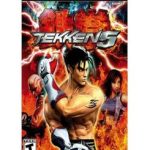One of the most recognizable games in the venerable Tekken series, which was created and distributed by Bandai Namco Entertainment, is Tekken 6. With its 2007 arcade debut and subsequent home platform releases on the PlayStation 3, Xbox 360, and PlayStation Portable, it represented a significant advancement for the franchise in terms of both graphics and gameplay complexity. In addition to adding new aspects that advanced the brand, it carried on the series’ reputation for fast-paced, combo-heavy battle techniques. As the sixth mainstream game, Tekken 6 developed the plot that fans had been following for years, improved the battle system, and included more characters.
The ongoing struggle within the Mishima family, which has fueled the Tekken tale since its beginning, lies at the heart of the game’s plot. Jin Kazama is introduced in Tekken 6 as the new leader of the Mishima Zaibatsu, a formidable organization that has effectively declared war on the whole globe. Jin has dual motivations because he wants to defeat Azazel, an ancient evil, and himself in the process. His primary adversary is his father, Kazuya Mishima, who is in charge of G Corporation; their conflict throws the entire globe into disarray. Players are given a compelling motivation to persevere through the numerous fights and character arcs as this plotline spins a web of treachery, retaliation, and fate.

With better mobility, more fluid animations, and an enhanced combo system, Tekken 6 improved the series’ signature 3D combat techniques. The “Bound” system, which gave players the ability to prolong combos by pushing their opponent to the ground and opening up new possibilities for high-damage sequences, was one of the game’s most notable elements. The already complex combat mechanics for which Tekken was renowned gained depth as a result. Every encounter is a thrilling test of timing, reflexes, and strategy thanks to the game’s enhanced wall combos and juggling mechanics. Tekken 6 stood out from its predecessors thanks to its greater focus on aggressiveness and creative combos.
Tekken 6’s extensive fighter roster, which was the biggest in the series at the time, is one of its main draws. More than 40 playable characters were included in the game, including newcomers Lars Alexandersson, Alisa Bosconovitch, Bob, and Zafina, as well as recurring favorites like Hwoarang, Paul Phoenix, King, and Nina Williams. Every player could choose a character that matched their tastes because each fighter had distinct combat styles, techniques, and personalities. Particularly important to the game’s story mode were Lars and Alisa, who gave the Tekken storyline a fresh angle. Every fight seemed new and exciting because of the variety of fighting techniques, which included gymnastics, robotic combat, and conventional martial arts.
Thanks to the updated engine, which supported high-definition graphics and intricate character models, Tekken 6 saw a significant visual advancement. With stages that may collapse or move to other locations in the middle of a battle, the settings were more dynamic and destructible. These changes not only offered visual flare but also altered gameplay, as players could tactically employ stage transitions to their advantage. Every punch, kick, and special move had a remarkable amount of impact, and the animations were more fluid than before. In addition to its story cutscenes and entrance scenes, which added a theatrical touch, Tekken 6 was a graphically spectacular fighting game at the time.
The mood of Tekken 6 was also greatly enhanced by the game’s soundtrack and sound design. Every level had a unique music that matched the location, which ranged from ancient ruins to urban battlegrounds. The sound effects provided each strike a pleasing sensation of power, while the upbeat and occasionally eerie techno songs increased the intensity throughout matches. Characters frequently yelled their battle cries or distinctive lines, and voice acting was available in several languages, which increased the realism and ferocity of the fight. Both casual gamers and competitive fighters found Tekken 6 to be an engaging experience because to its potent graphics and engrossing music.



The “Scenario Campaign” mode, a novel addition to Tekken 6 that combined beat-’em-up aspects with traditional combat, was another noteworthy feature. Players took control of characters like Lars and Alisa in this mode, fighting their way through waves of foes in different locales while learning bits of the plot from cutscenes and conversation. This mode was commended for providing an alternative to the typical arcade ladder, but receiving mixed reviews because of its somewhat tedious gameplay and strange camera angles. It gave players an incentive to go further into the Tekken universe than just one-on-one combat and set the scene for the main plot.
System Requirements OF Tekken 6 Highly Compressed PC
| Ram | 2 GB RAM |
|---|---|
| Processor | Intel Core 2 Duo E8400 |
| Accessories | Keyboard, mouse, and speaker |
| Graphics card | NVIDIA GeForce 6600 |
| Windows | Xp, 7, 8, 8.1, 10, and 11 |
| Free disk space | 18 GB |
A major factor in Tekken 6’s enduring appeal, both online and off, was multiplayer. Players may test their talents in both ranked and unranked battles against opponents from all around the world in the online mode. Offline, friends and arcade enthusiasts continued to love the timeless vs mode since it provided countless replay opportunities. Players may alter the look of their favorite fighters by adding various clothing, accessories, and even silly stuff thanks to the game’s character customization feature. This feature gives players more motivation to keep playing and collecting in-game awards while also personalizing the competition experience.
Critics praised Tekken 6’s depth, visual appeal, and extensive character pool, and the game received a generally good review. In its day, it set the standard for 3D fighting games and sparked a plethora of competitions and tournaments. The game’s presentation and fundamental concepts were sufficient to make it a commercial success, despite some players’ complaints about load times and specific balancing problems. Later entries in the franchise, such as Tekken Tag Tournament 2 and Tekken 7, both of which expanded on or improved upon the systems that Tekken 6 established, were nonetheless influenced by its legacy. Because of its ambitious scale and timeless replay potential, the game continues to be a revered part in the series’ history.
Fans still have a particular place in their hearts for Tekken 6, even after years have passed since its debut. It captures a period when fighting games were developing quickly, bridging the gap between the console age and arcade history. Its reputation as one of the greatest fighting games of its generation was guaranteed by its unique blend of technical skill, poignant narrative, and intense action. Not simply another sequel, Tekken 6 was the pinnacle of the franchise, setting the stage for new developments while remaining loyal to its original principles. Tekken 6 is still a great example of why the franchise is still regarded as one of the most prestigious in gaming history, regardless of whether it is played again for nostalgia’s sake or is found by new players.

